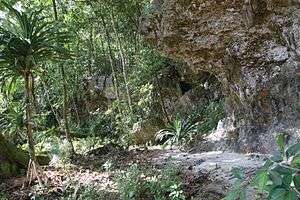New Britain-New Ireland lowland rain forests
The New Britain-New Ireland lowland rain forests is a tropical moist forest ecoregion in Papua New Guinea. The ecoregion covers the lowland rain forests of New Britain, New Ireland, and nearby islands in the Bismarck Archipelago.
| New Britain-New Ireland lowland rain forests | |
|---|---|
 coastal forest on karst, Mussau Island | |
| Ecology | |
| Realm | Australasian realm |
| Biome | tropical and subtropical moist broadleaf forests |
| Borders | New Britain-New Ireland montane rain forests |
| Geography | |
| Area | 39,570 km2 (15,280 sq mi) |
| Countries | Papua New Guinea |
| Provinces | East New Britain, Madang, Morobe, New Ireland, and West New Britain |
| Conservation | |
| Conservation status | Critical/endangered |
| Protected | 1,026 km² (3%)[1] |
Geography
The Bismarck Archipelago is a group of islands lying northeast of the island of New Guinea in Papua New Guinea. The ecoregion includes the lowland rain forests on New Britain, New Ireland, and nearby smaller islands, including Umboi, Long Island, and Karkar, near the New Guinea coast west of New Britain. The islands north of New Ireland, including New Hanover (Lavongai), the Saint Matthias Group, Tabar Group, Lihir Group, Tanga Islands, and Feni Islands, are also part of the ecoregion.[2]
New Britain is the largest island in the ecoregion, with an area of 36,520 km². New Ireland is the second-largest, with an area of 7,404 km². The archipelago is mostly made of volcanic rocks, with extensive areas of limestone. Several of the ecoregion's volcanoes are still active. The islands are generally mountainous, with Mount Ulawun on New Britain reaching 2,334 m (7,657 ft). The portions of New Britain and New Ireland above 1000 meters elevation constitute the separate New Britain-New Ireland montane rain forests ecoregion.
Climate
The ecoregion has a tropical wet climate. Annual rainfall varies from 1500 to 6000 mm, depending on location.[3]
Flora
The predominant vegetation in the ecoregion is tropical rain forest.[4]
Fauna
The ecoregion has 47 species of mammals. 36 of them are bats, and the rest are murid rodents or marsupials.[5]
Protected areas
A 2017 assessment found that 1,026 km², or 3%, of the ecoregion is in protected areas. About two-thirds of the unprotected area is still forested.[7]
External links
- "New Britain-New Ireland lowland rain forests". Terrestrial Ecoregions. World Wildlife Fund.
References
- Eric Dinerstein, David Olson, et al. (2017). An Ecoregion-Based Approach to Protecting Half the Terrestrial Realm, BioScience, Volume 67, Issue 6, June 2017, Pages 534–545; Supplemental material 2 table S1b.
- Wikramanayake, Eric; Eric Dinerstein; Colby J. Loucks; et al. (2002). Terrestrial Ecoregions of the Indo-Pacific: a Conservation Assessment. Washington, DC: Island Press.
- Wikramanayake, Eric; Eric Dinerstein; Colby J. Loucks; et al. (2002). Terrestrial Ecoregions of the Indo-Pacific: a Conservation Assessment. Washington, DC: Island Press.
- Wikramanayake, Eric; Eric Dinerstein; Colby J. Loucks; et al. (2002). Terrestrial Ecoregions of the Indo-Pacific: a Conservation Assessment. Washington, DC: Island Press.
- "New Britain-New Ireland lowland rain forests". Terrestrial Ecoregions. World Wildlife Fund.
- "New Britain-New Ireland lowland rain forests". Terrestrial Ecoregions. World Wildlife Fund.
- Eric Dinerstein, David Olson, et al. (2017). An Ecoregion-Based Approach to Protecting Half the Terrestrial Realm, BioScience, Volume 67, Issue 6, June 2017, Pages 534–545; Supplemental material 2 table S1b.